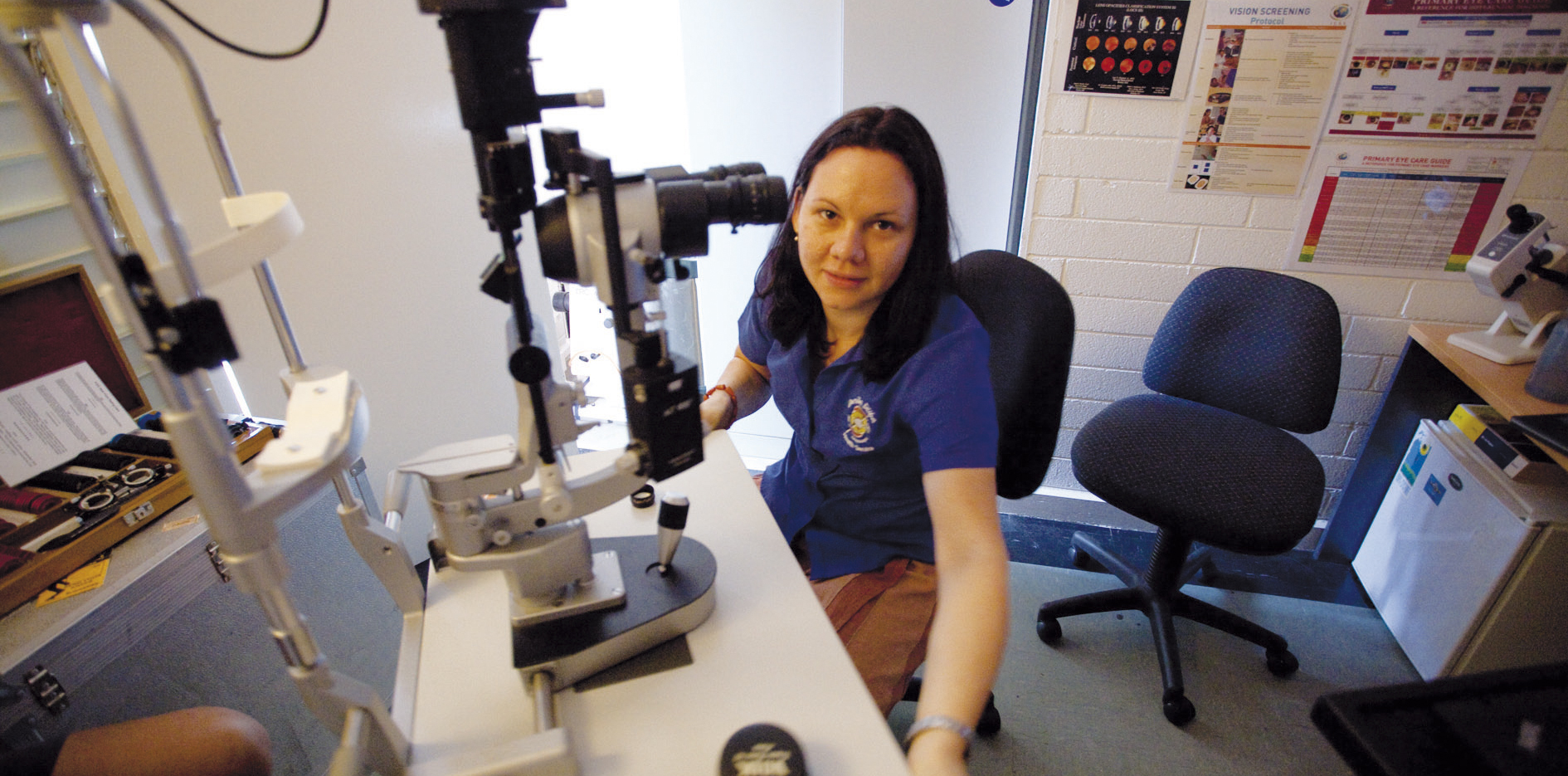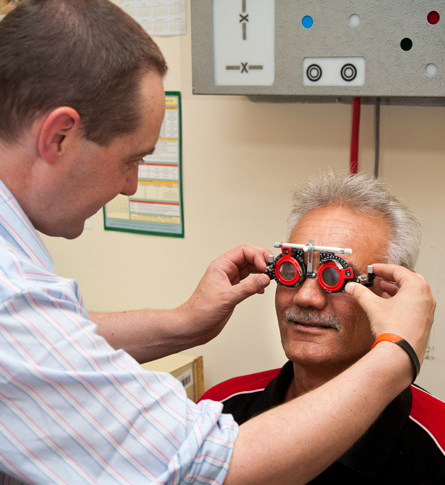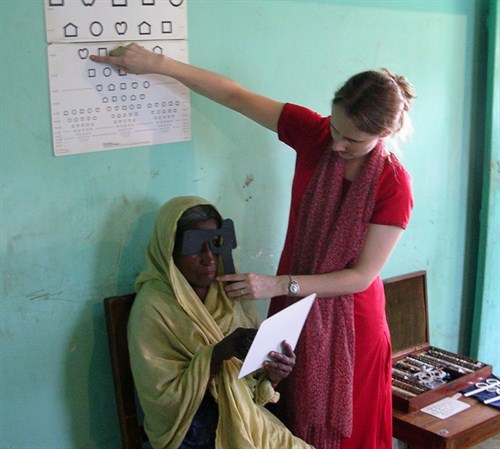1:30min

Anna Morse
______________________________
The contributions of seven optometrists to improving the eye health of Australians nationwide have been recognised as part of World Sight Day 2014. One optometrist of each state division of Optometry Australia was nominated as an Eye Health Hero and several featured in radio interviews on 9 October.
They are David Bradley (Brisbane QLD), Piers Carozzi (Melbourne VIC), Gary Crerie (Perth WA), Ben Hamlyn (Adelaide SA), Leah McClintock (Launceston TAS), Robert Merrington (Gosford NSW) and Anna Morse (Darwin NT).
Indigenous and remote work features prominently but optometrists were also recognised for behavioural optometry, and their work helping the homeless and people in Bangladesh.
David Bradley
David Bradley’s 15-year contribution to improving the eye health of Aboriginal and Torres Strait Islander communities started in Alice Springs.
‘In the early days, the focus was very much on treating conditions such as trachoma and cataracts, while now the prevailing issues relate to diabetic eye disease and hypertensive retinopathy,’ he said.
Mr Bradley, a Brisbane optometrist who is a director of Optometry Queensland/ Northern Territory, usually makes three one-week visits to the Ngaanyatjarra region in Western Australia every year. He says there has been a massive improvement in eye health in the area and in awareness of how and why people should look after their eye health.
Mr Bradley also helps provide mobile services with other eye-health and health workers via the Indigenous Diabetes Eyes and Screening van to indigenous communities in Queensland. In the past year, the service has treated more than 2,500 patients.
Piers Carozzi
Melbourne optometrist Piers Carozzi was recognised for his work helping some of Victoria’s most vulnerable people, providing outreach optometry services to St Kilda’s homeless.
As lead optometrist of outreach services at the Australian College of Optometry, he co-ordinates a team of 12 optometrists contributing to the homeless program, which began 11 years ago. They use a purpose-equipped van and offer services including retinal photography and low-cost spectacles.
‘It can be confronting to meet a guy in his 40s with no fixed address, clearly smelling of alcohol, not a clean, neatly-dressed patient,’ Mr Carozzi said.
‘There are always challenges but by being able to throw more resources at homeless services we have been able to open new sites. Word of mouth has been big so we have had to open in a range of locations giving the best access.’
 |
|
Piers Carozzi (Photo: ACO) |
Gary Crerie
Perth-based optometrist Gary Crerie played a key role in the development of the North West Eye Program, which provides eye care to remote communities in the Kimberley and Pilbara regions. He became involved after seeing the outreach work of optometrist Margie O’Neill who was the key figure in the establishment of the program.
Mr Crerie saw the need to support her work with a sustainable program and organised a team of 13 volunteer optometrists to contribute two weeks a year to visiting remote parts of the state.
‘People in these communities are now more aware of why it’s important to look after their eyes and more willing to seek treatment,’ he said.
Mr Crerie was also recognised for his 33 years working to improve literacy skills in children through vision programs delivered at his Leeming-based practice. He developed programs with his occupational therapist wife, including home vision-training using colours, lenses and prisms.
 |
| Gary Crerie |
Ben Hamlyn
Flinders University School of Health Sciences associate lecturer, Ben Hamlyn, has spent much of the past four years visiting and providing eye care and treatment to remote communities in South Australia, the Northern Territory and Papua New Guinea.
‘After graduating I became involved in optometrist outreach services in the Northern Territory through the Fred Hollows Foundation and worked in about 25 communities,’ he said.
Since then he has continued to provide support to local health authorities in remote communities, work he finds extremely rewarding.
These experiences have inspired his research and teaching work at Flinders. He says creating high-quality graduate optometrists will ensure access to the best eye care in the future.
Mr Hamlyn has been working on developing a retinopathy screening program for remote areas and hopes a screening network will be established in 12 to 18 months.
Leah McClintock
Leah McClintock, an optometrist from OPSM Launceston, has spent much of the past decade helping to raise awareness and improve access to eye-care services in Bangladesh.
Ms McClintock moved to Dhaka with her husband Jeff and two young children in 2004 after being invited to work with Symbiosis, a local aid and development organisation.
She undertook a local community eye health course and developed an eye-care program called SPECS, funded by Optometry Giving Sight, to visit areas with the least access to services, offering primary eye-care services, eye health education, school vision screening and referral for surgery.
She lived there until 2008, working with local staff to establish the program in many rural locations.
‘It’s been such a rewarding program and some of its greatest achievements involved the eye-health lessons we provided to village women, many of whom were illiterate so we used illustrated flipcharts to teach them about common eye conditions affecting their communities and how to improve the eye health of their families,’ she said.
 |
| Leah McClintock |
Robert Merrington
As part of the Brien Holden Vision Institute (BHVI) Aboriginal Vision Program, Gosford-based optometrist Robert Merrington visits regularly a circuit of remote communities, including Ivanhoe, Hay, Deniliquin and Lightning Ridge.
‘I complete the circuit every three to four months, so by the time I get back to each of the communities, I see a marked difference from the previous visit. I’ve established great relationships with the local health providers and with the patients, and this has been crucial to finding the best solutions and outcomes,’ Mr Merrington said.
Mr Merrington spent 50 years running his own optometric practice before joining the institute. Over the past two years he has provided eye care in more than 40 towns and locations around NSW.
‘The moment that made me proudest was when a young mother who I’d treated told me that based on the change it had made to her quality of life, she now wants to help others in her community with eye-health awareness,’ he said.
Anna Morse
Darwin-based optometrist Anna Morse is project manager with the BHVI program.
With her team she co-ordinates optometric services delivered to about 80 community health centres and Aboriginal Medical Services, mainly in very remote areas of the Northern Territory.
The program has made remarkable progress in improving eye care in the region, with a doubling in the number of optometric examinations provided in remote communities in the past five years, from 2,851 in 2010 to 5,546 in 2014.
Ms Morse, who serves on Optometry Australia’s Aboriginal and Torres Strait Islander Eye Health Working Group, has made a significant contribution to improving Aboriginal eye health in the Northern Territory through clinical, research and education roles.
‘The work we do can be challenging but also highly rewarding. We do it because we love it.
‘I consider myself very fortunate to work with a group of optometrists who are committed to providing high-quality comprehensive eye care in some of the remotest places of Australia,’ she said.